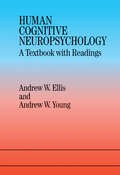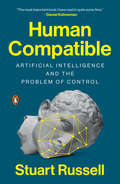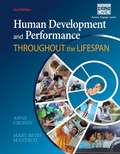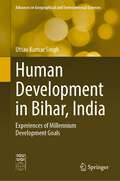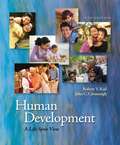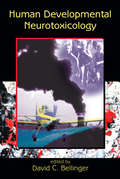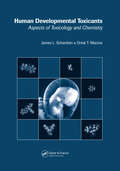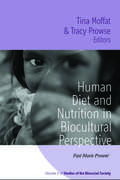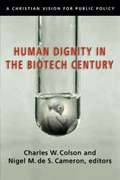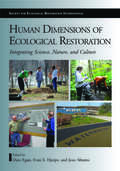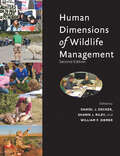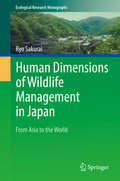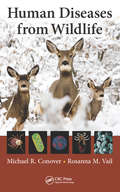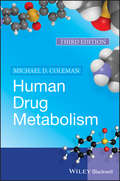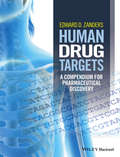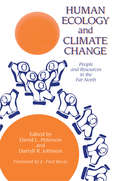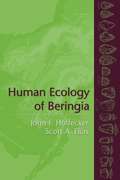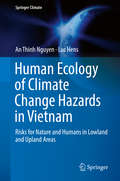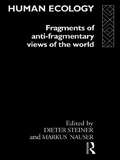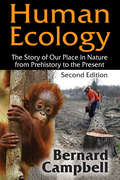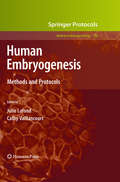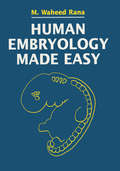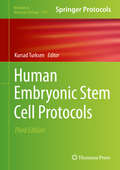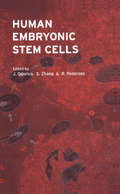- Table View
- List View
Human Cognitive Neuropsychology: A Textbook With Readings
by Andrew W. Ellis Andrew W. YoungThis textbook augments the first edition through the inclusion of a set of reseach and review papers selected by the authors to supplement the contents of each chapter by providing a discussion of research issues and detailed investigation of individual cases. One or two papers supplement each chapter. A short introduction to each set makes clear the nature of their contribution and how they relate to each chapter's contents. Some of the papers are short reviews of theoretical contributions; others are case studies in the tradition of cognitive neuropsychology. At least three of the main trends discernible in cognitive neuropsychology in the 1990s are represented in the chosen papers. The first is the use of connectionist models to simulate patterns of impairment in brain-injured patients. The second is the growing convergence between cognitive neuropsychology and neuroscience: cognitive neuropsychologists are becoming increasingly interested in the brain processes that underlie the preserved and damaged psychological processes they study. The third trend is the involvement of cognitive neuropsychologists in work on therapy and rehabilitation.
Human Compatible: Artificial Intelligence and the Problem of Control
by Stuart Russell"The most important book I have read in quite some time" (Daniel Kahneman); "A must-read" (Max Tegmark); "The book we've all been waiting for" (Sam Harris)A leading artificial intelligence researcher lays out a new approach to AI that will enable us to coexist successfully with increasingly intelligent machinesLonglisted for the 2019 Financial Times/McKinsey Business Book of the Year AwardIn the popular imagination, superhuman artificial intelligence is an approaching tidal wave that threatens not just jobs and human relationships, but civilization itself. Conflict between humans and machines is seen as inevitable and its outcome all too predictable. In this groundbreaking book, distinguished AI researcher Stuart Russell argues that this scenario can be avoided, but only if we rethink AI from the ground up. Russell begins by exploring the idea of intelligence in humans and in machines. He describes the near-term benefits we can expect, from intelligent personal assistants to vastly accelerated scientific research, and outlines the AI breakthroughs that still have to happen before we reach superhuman AI. He also spells out the ways humans are already finding to misuse AI, from lethal autonomous weapons to viral sabotage. If the predicted breakthroughs occur and superhuman AI emerges, we will have created entities far more powerful than ourselves. How can we ensure they never, ever, have power over us? Russell suggests that we can rebuild AI on a new foundation, according to which machines are designed to be inherently uncertain about the human preferences they are required to satisfy. Such machines would be humble, altruistic, and committed to pursue our objectives, not theirs. This new foundation would allow us to create machines that are provably deferential and provably beneficial.In a 2014 editorial co-authored with Stephen Hawking, Russell wrote, "Success in creating AI would be the biggest event in human history. Unfortunately, it might also be the last." Solving the problem of control over AI is not just possible; it is the key that unlocks a future of unlimited promise.
Human Development and Performance Throughout the Lifespan
by Anne Cronin Mary Beth MandichHuman Development & Performance Throughout the Lifespan, 2nd Edition is ideal for occupational therapy, physical therapy, and other rehabilitation disciplines. It provides a broad, occupation-based viewpoint of development and performance throughout all life stages with an emphasis on the factors that influence daily participation and optimal performance of desired daily life tasks. The authors use a life course conceptual model as an organizational foundation for clinical reasoning to help readers understand how to implement the activity- and participation-based goals and outcomes for therapy. Written by an occupational therapist and a physical therapist, the book incorporates chapters by leading experts in human development, giving users cutting-edge information and a wide range of perspectives. By integrating information from the International Classification of Function and Disability (ICF) with a developmental life-task perspective, the book gives both newcomers and experienced professionals an essential, contemporary frame of reference.
Human Development in Bihar, India: Experiences of Millennium Development Goals (Advances in Geographical and Environmental Sciences)
by Utsav Kumar SinghThis book introduces the issues of the contemporary state of Bihar, India, in terms of its performance on the Millennium Development Goals (MDGs) indicators and the initiatives taken by the central and state governments towards realizing human development. Doing so, it draws upon the mistakes committed in the past and moves ahead towards a better future with the idea of sustainable human development. The book also presents a comprehensive evaluation of the background and indicators of the human development index, and it analyses the impact of COVID-19 on India in general and on Bihar in particular. India is a nation of unbalanced states in terms of development. In spite of all the development initiatives, India still contains states that have not conformed to the breakthrough claimed by the nation, and the state of Bihar falls under this category. Bihar has emerged as the worst performer in human development, based on the ranking of the Human Development Index 2020. Nevertheless, Bihar has the potential for overall development to achieve its glorious past once again, by various pro-poor policies implemented by the government of Bihar in the last two decades, which is critically analysed in detail.
Human Development: A Life-Span View
by John Cavanaugh Robert KailBalanced coverage of the entire life span is just one thing that distinguishes HUMAN DEVELOPMENT: A LIFE-SPAN VIEW, 6TH EDITION. With its comprehensive, succinct, and applied coverage, the text has proven its ability to capture students' interest while introducing them to the issues, forces, and outcomes that make us who we are. Robert V. Kail's expertise in childhood and adolescence, combined with John C. Cavanaugh's extensive research in gerontology, result in a book with a rich description of all life-span stages and important topics. A modified chronological approach traces development in sequential order from conception through late life, while also dedicating several chapters to key topical issues. This organization also allows the book to be relatively briefer than other texts a benefit given the enormous amount of information covered in the course.
Human Developmental Neurotoxicology
by Nasimul AhsanThis reference describes the most recent developments in the design, execution, and interpretation of human developmental neurotoxicology studies. Assessing critical issues and controversies in the field, this guide focuses on dose-response/effect relationships and explores challenges in the measurement of exposure to different types of chemicals,
Human Developmental Toxicants: Aspects of Toxicology and Chemistry
by James L. Schardein Orest T. MacinaPresenting the first database of its kind, this unique reference illustrates the relationships between the chemistry and developmental toxicity of a number of important pharmaceuticals and industrial toxicants. Human Developmental Toxicants contains up-to-date and concise information on the chemical structures, properties, and biological activities
Human Diet And Nutrition In Biocultural Perspective
by Tina Moffat Tracy ProwseThere are not many areas that are more rooted in both the biological and social-cultural aspects of humankind than diet and nutrition. Throughout human history nutrition has been shaped by political, economic, and cultural forces, and in turn, access to food and nutrition has altered the course and direction of human societies. Using a biocultural approach, the contributors to this volume investigate the ways in which food is both an essential resource fundamental to human health and an expression of human culture and society. The chapters deal with aspects of diet and human nutrition through space and time and span prehistoric, historic, and contemporary societies spread over various geographical regions, including Europe, North America, Africa, and Asia to highlight how biology and culture are inextricably linked.
Human Dignity in the Biotech Century: A Christian Vision for Public Policy
by Nigel M. de S. Cameron Charles W. ColsonWhat will be the greatest moral challenge facing our society throughout this century?Are we ready to face it?Editors Charles W. Colson and Nigel M. de S. Cameron, along with a panel of expert contributors, make the case in this book that the greatest watershed debates of the twenty-first century concerning ethics and public policy will surround the issue of biotechnology. In twelve essays they address several of the legal and ethical challenges before us: embryo research, stem cell research, cloning, genetic engineering, gene therapy, pharmacogenomics, cybernetics, nanotechnology and, of course, abortion. Contributors includeWilliam L. Saunders, J. D. , Family Research CouncilChristopher Hook, M. D. , The Mayo ClinicHenk Jochemsen, Ph. D. , Free University of AmsterdamDavid A. Prentice, Ph. D. , Indiana State UniversityNathan A. Adams IV, Ph. D. , J. D. , Christian Legal SocietyDavid Stevens, M. D. , Christian Medical AssociationPaige Comstock Cunningham, J. D. , Americans United for LifeC. Ben Mitchell, Ph. D. , Trinity Evangelical Divinity SchoolRichard Doerflinger, M. A. , Secretariat for Pro-life, National Conference of Catholic BishopsWesley J. Smith, J. D. , International Task Force on Euthanasia and Assistend SuicideLeaders in their fields, these contributors point out the crucial role Christians can and should play in the public square. The well-informed and forward-looking perspectives they present will help us prepare for the challenges ahead.
Human Dimensions of Ecological Restoration: Integrating Science, Nature, and Culture (Science Practice Ecological Restoration)
by Jesse Abrams Evan E. Hjerpe Dave EganHuman Dimensions of Ecological Restoration takes an interdisciplinary look at the myriad human aspects of ecological restoration. In twenty-six chapters written by experts from around the world, it provides practical and theoretical information, analysis, models, and guidelines for optimizing human involvement in ecological restoration projects. The book delves into the often-neglected aspects of ecological restoration that ultimately make the difference between projects that are successfully executed and maintaned with the support of informed, engaged citizens, and those that are unable to advance past the conceptual stage due to misunderstandings or apathy. The lessons contained will be valuable to restoration veterans and greenhorns alike, scholars and students in a range of fields, and individuals who care about restoring their local lands and waters.
Human Dimensions of Wildlife Management
by Daniel J. DeckerUpdated and revised, this classic work is a must-read for every student of wildlife management and every professional seeking to become a better manager.Wildlife professionals can more effectively manage species and social-ecological systems by fully considering the role that humans play in every stage of the process. Human Dimensions of Wildlife Management provides the essential information that students and practitioners need to be effective problem solvers. Edited by three leading experts in wildlife management, this textbook explores the interface of humans with wildlife and their sometimes complementary, often conflicting, interests. The book's well-researched chapters address conservation, wildlife use (hunting and fishing), and the psychological and philosophical underpinnings of wildlife management. Human Dimensions of Wildlife Management explains how a wildlife professional should handle a variety of situations, such as managing deer populations in residential areas or encounters between predators and people or pets.This thoroughly revised and updated edition includes detailed information about• systems thinking• working with social scientists• managing citizen input• using economics to inform decision making• preparing questionnaires• ethical considerations
Human Dimensions of Wildlife Management in Japan: From Asia to the World (Ecological Research Monographs)
by Ryo SakuraiThis book discusses the findings of research on the human dimensions of wildlife management conducted in Japan, demonstrating how such research and approaches have contributed to mitigating human-wildlife conflicts.Human-wildlife conflicts, including agricultural and property damage as well as occasional casualties, are a global problem for which local residents, managers, and stakeholders around the world are struggling to find solutions. Human dimensions of wildlife management (HDW) is an academic field developed in North America in the 1970s to gather information on the social aspects of human-wildlife issues to help wildlife managers and stakeholders implement effective decision-making measures. However, HDW is not widely recognized or applied outside North America, and few studies have investigated whether HDW approaches would be effective in different cultural settings.This is the first book written in English to introduce the HDW theories and practices implemented in Asia. Presenting innovative approaches and research techniques, as well as tips on how to introduce HDW methods into culturally different societies, it is a valuable resource not only for researchers and students in this field, but also for government officials/managers, NGOs, residents and other stakeholders who are affected by human-wildlife conflicts around the globe.
Human Dimensions of Wildlife Management in North America
by Daniel J. Decker Tommy L. Brown William F. SiemerThe term human dimensions covers a broad set of ideas and practices, including economic and social values, individual and group behavior, citizen involvement in planning and implementation of management, and communication.
Human Diseases from Wildlife
by Michael R. Conover Rosanna M. VailHuman Diseases from Wildlife presents information on the most prevalent and serious zoonotic diseases in the US and Canada, some of which have been national headline news like anthrax, influenza, and West Nile virus. Diseases that are caused by pathogens with the ability to infect both humans and animals are known as zoonotic diseases, which litera
Human Drug Metabolism: An Introduction
by Michael D. ColemanProvides a timely update to a key textbook on human drug metabolism The third edition of this comprehensive book covers basic concepts of teaching drug metabolism, starting from extreme clinical consequences to systems and mechanisms and toxicity. It provides an invaluable introduction to the core areas of pharmacology and examines recent progress and advances in this fast moving field and its clinical impact. Human Drug Metabolism, 3rd Edition begins by covering basic concepts such as clearance and bioavailability, and looks at the evolution of biotransformation, and how drugs fit into this carefully managed biological environment. More information on how cytochrome P450s function and how they are modulated at the sub-cellular level is offered in this new edition. The book also introduces helpful concepts for those struggling with the relationship of pharmacology to physiology, as well as the inhibition of biotransformational activity. Recent advances in knowledge of a number of other metabolizing systems are covered, including glucuronidation and sulphation, along with the main drug transporters. Also, themes from the last edition are developed in an attempt to chart the progress of personalized medicine from concepts towards practical inclusion in routine therapeutics. The last chapter focuses on our understanding of how and why drugs injure us, both in predictable and unpredictable ways. Appendix A highlights some practical approaches employed in both drug metabolism research and drug discovery, whilst Appendix B outlines the metabolism of some drugs of abuse. Appendix C advises on formal examination preparation and Appendix D lists some substrates, inducers and inhibitors of the major human cytochrome P450s. Fully updated to reflect advances in the scientific field of drug metabolism and its clinical impact Reflects refinements in the author's teaching method, particularly with respect to helping students understand biological systems and how they operate Illustrates the growing relationship between drug metabolism and personalized medicine Includes recent developments in drug discovery, genomics, and stem cell technologies Human Drug Metabolism, 3rd Edition is an excellent book for advanced undergraduate and graduate students in molecular biology, biochemistry, pharmacology, pharmacy, and toxicology. It will also appeal to professionals interested in an introduction to this field, or who want to learn more about these bench-to-bedside topics to apply it to their practice.
Human Drug Targets
by Edward D. ZandersThe identification of drug targets in a given disease has been central to pharmaceutical research from the early days of pharmacology right up to the modern genomics era. Human Drug Targets provides an essential guide to one of the early most important aspects of drug discovery - the identification of suitable protein and RNA targets prior to the creation of drug development candidates. The first part of the book consists of introductory chapters that provide the background to drug target discovery and highlight the way in which these targets have been organised into online databases. It also includes a user's guide to the list of entries that forms the bulk of the book. Since this is not designed to be a compendium of drugs, the emphasis will be on the known (or speculated) biological role of the targets and not on the issues associated with pharmaceutical development. The objective is to provide just enough information to be informative and prompt further searches, while keeping the amount of text for each of the many entries to a minimum. Human Drug Targets will prove invaluable to those drug discovery professionals, in both industry and academia, who need to make some sense of the bewildering array of online information sources on current and potential human drug targets. As well as creating order out of a complex target landscape, the book will act as an ideas generator for potentially novel targets that might form the basis of future discovery projects.
Human Ecology And Climatic Change: People And Resources In The Far North
by David L. Peterson Darryll R. JohnsonThe Far North, a land of extreme weather and intense beauty, is the only region of North America whose ecosystems have remained reasonably intact. Humans are newcomers there and nature predominates. As is widely known, recent changes in the Earth's atmosphere have the potential to create rapid climatic shifts in our life-time and well into the future. These changes, a product of southern industrial society, will have the greatest impact on ecosystems at northern latitudes, which until now have remained largely undisturbed. In this fragile balance, as terrestrial and aquatic habitats change, animal and human populations will be irrevocably altered.
Human Ecology of Beringia
by John Hoffecker Scott EliasTwenty-five thousand years ago, sea level fell more than 400 feet below its present position as a consequence of the growth of immense ice sheets in the Northern Hemisphere. A dry plain stretching 1,000 miles from the Arctic Ocean to the Aleutians became exposed between northeast Asia and Alaska, and across that plain, most likely, walked the first people of the New World. This book describes what is known about these people and the now partly submerged land, named Beringia, which they settled during the final millennia of the Ice Age.Humans first occupied Beringia during a twilight period when rising sea levels had not yet caught up with warming climates. Although the land bridge between northeast Asia and Alaska was still present, warmer and wetter climates were rapidly transforming the Beringian steppe into shrub tundra. This volume synthesizes current research-some previously unpublished-on the archaeological sites and rapidly changing climates and biota of the period, suggesting that the absence of woody shrubs to help fire bone fuel may have been the barrier to earlier settlement, and that from the outset the Beringians developed a postglacial economy similar to that of later northern interior peoples.The book opens with a review of current research and the major problems and debates regarding the environment and archaeology of Beringia. It then describes Beringian environments and the controversies surrounding their interpretation; traces the evolving adaptations of early humans to the cold environments of northern Eurasia, which set the stage for the settlement of Beringia; and provides a detailed account of the archaeological record in three chapters, each of which is focused on a specific slice of time between 15,000 and 11,500 years ago. In conclusion, the authors present an interpretive summary of the human ecology of Beringia and discuss its relationship to the wider problem of the peopling of the New World.
Human Ecology of Climate Change Hazards in Vietnam: Risks for Nature and Humans in Lowland and Upland Areas (Springer Climate)
by An Thinh Nguyen Luc HensThis book analyzes climate change associated effects in the mountainous and coastal environments of Vietnam. The scope of the book allows international comparisons to be made between these two affected areas and other similarly affected locations under constant environmental pressure. Frequent and intense climate change hazards are described, along with a wider context of integrated interpretations, socioeconomic implications and policy responses. The book reports on original research combining methodologies from the natural sciences with approaches in human sciences, providing an interdisciplinary human ecological context to analyze similar situations worldwide. The book is structured in four parts. The first part offers background information, and details the human ecological framework. The geography of the analyzed regions is discussed to reflect the environmental and socioeconomic context of Vietnam's coasts and mountains. The second part addresses the coast of Central Vietnam. The effects of tropical storms, floods, rising sea levels and coastal erosion in Ky Anh are studied to highlight the impacts on the local population and its development perspectives. The third part focuses on the uplands of Northern Vietnam. The effects of cyclones, heavy rains, floods, flash floods, and landslides in the Van Chan Mountains are studied to compare the biophysical and socioeconomic impacts. Part four makes policy recommendations in building resilient landscapes and green cities, and discusses the potential implications of findings for practice in Vietnam. The book addresses a wide array of researchers, geography and economics students, consultants and decision makers interested in the actual status and the likely developments on the physical, socioeconomic and mitigation and adaptation attitudes and policies of climate change associated effects.
Human Ecology: Fragments Of Anti-fragmentary Views Of The World
by Dieter Steiner Markus NauserWe face an environmental catastrophe of global proportions. The ecological rationality of modern society, and of science in particular, is in question. Science still responds to crises at the level of technocratic expertise, and still treats society as an adaptive system. By bringing together a number of integrative approaches to the human-environment problem, Human Ecology shapes a more radical, fundamental agenda for change. The book creates a framework for a cohesive discourse, for a "new human ecology". From the notion that the individual person is an agent mediating between society and environment, the individual contributors recognize that the environmental crisis is really a crisis of society - manifesting itself in an increasing fragmentation of lives in general and knowledge in particular. Arguing for environmentally sustainable lifestyles, the book envisages a new kind of consciousness and a new environment.
Human Ecology: The Story of Our Place in Nature from Prehistory to the Present
by Bernard CampbellThis new edition of a widely adopted primary and supplementary text explores human adaptations to environments over time. It is biologically and culturally sophisticated, drawing on an impressive array of archaeological and paleontological research. Campbell proceeds from earlier, simpler biomes to later, more complex ones, examining selected aspects of the prehistory and history of the human species. Human Ecology offers a succinct introduction to the history of these adaptations within ecosystems: a shared concern among anthropologists, biologists, environmentalists, and the general reader.In the years since this book was first published, the problems that the human species has faced have become more serious. As predicted, world population has rapidly increased, and with it starvation, malnutrition, and disease. Our precious environment is being devastated. In particular, the tropical rain forests, our richest resource, are being cut and burned at an alarming rate with the accompanying degradation of the forest soils. Their flora and fauna, including their human inhabitants, are being destroyed. All this is being done for short-term financial gain without any long-term planning or understanding of the risks involved.There are no simple and humane short-term solutions to the central problem of increasing population pressure. In the long-term, the only hope of making possible a life of quality for all, rather than a life of starvation and squalor, is through education. It is essential that we understand the limits that exist to the earth's productivity and the overriding importance of maintaining richly diversified fauna and flora. If we understand how we arrived at this life-threatening situation, the resolution will become clear. Non-violent and viable solutions do exist and can be implemented, but the human race first must understand and face up to the nature of its frightening predicament.
Human Embryogenesis
by Julie Lafond Cathy VaillancourtDespite its inherent controversy, the exploration of the human embryo can unlock many of the answers to our deepest biological questions. In Human Embryogenesis: Methods and Protocols, internationally recognized researchers contribute detailed methods to analyze various aspects of the embryogenesis process. While comprehensively covering subjects such as the molecular mechanisms of embryonic development, in vitro fertilization, cloning, and the laws and ethical considerations of working with embryos, the volume also addresses critical features of fetal and placental development as well as of uterine biology. Written in the highly successful Methods in Molecular BiologyTM series format, chapters include introductions to their respective topics, lists of the necessary materials and reagents, step-by-step, readily reproducible laboratory protocols, and notes on troubleshooting and avoiding known pitfalls. Authoritative and state-of-the-art, Human Embryogenesis: Methods and Protocols provides a firm foundation for the successful analysis of the embryogenesis process and an easily accessible description of the limitations and advantages of the techniques proposed, certain to aid all those who wish to further unravel the mysteries of human embryogenesis.
Human Embryology Made Easy
by Abdul Hamid RanaThis book is a synopsis of the key facts and concepts of human development. It is intended for students who are taking a human embryology course. The book includes the underlying mechanisms involved in clinically important congenital anomalies that will prove useful to medical and nursing.
Human Embryonic Stem Cell Protocols
by Kursad TurksenDespite political and ethical controversies surrounding the study of human embryonic stem (hES) cells, new freedoms in regard to using them for research has allowed interest to remain high in understanding the regulatory mechanisms of stem cell self-renewal, their differentiation along various lineages, and their potential use in regenerative medicine. In Human Embryonic Stem Cell Protocols, Second Edition, internationally respected researchers expand upon the popular first edition and describe in detail their most useful techniques for the molecular and cellular manipulation of these intriguing cells. This diverse collection of readily reproducible methods has been optimized for the derivation, characterization, and differentiation of hES cells, with special attention given to regenerative medicine applications. As a volume of the Methods in Molecular BiologyTM series, chapters include brief introductions to their respective topics, lists of the necessary materials and reagents, step-by-step laboratory protocols, and notes on troubleshooting and avoiding known pitfalls. Comprehensive and cutting-edge, Human Embryonic Stem Cell Protocols, Second Edition offers both novice and expert researchers powerful tools essential to understanding the maintenance and differentiation of human embryonic stem cells, as well as their applications in regenerative medicine today.
Human Embryonic Stem Cells
by J. Odorico S. C. Zhang R. PedersenSince the first successful isolation and cultivation of human embryonic stem cells at the University of Wisconsin, Madison in 1998, there has been high levels of both interest and controversy in this area of research. This book provides a concise overview of an exciting field, covering the characteristics of both human embryonic stem cells and pluripotent stem cells from other human cell lineages. The following chapters describe state-of-the-art differentiation and characterization of specific ectoderm, mesoderm and endoderm-derived lineages from human embryonic stem cells, emphasizing how these can be used to study human developmental mechanisms. A further chapter discusses genetic manipulation of human ES cells. The concluding section covers therapeutic applications of human ES cells, as well as addressing the ethical and legal issues that this research have raised.
